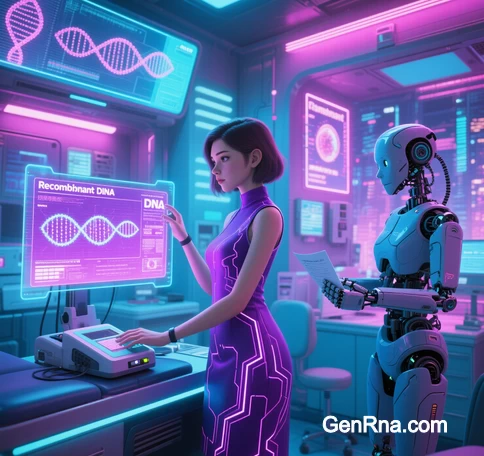 Introduction
Introduction
Recombinant DNA (rDNA) technology is a cornerstone of modern biotechnology, enabling scientists to create novel genetic combinations by integrating DNA fragments from different biological sources. First demonstrated by Herbert Boyer and Stanley Cohen in 1973 using E. coli plasmids and restriction enzymes, this revolutionary technique allows for the precise manipulation of genetic material. The process harnesses molecular tools to isolate, cut, splice, and express target genes in host organisms, paving the way for advancements in medicine, agriculture, and industrial biotechnology. This article details the systematic workflow of rDNA technology, highlighting its molecular mechanisms and real-world applications.
Step 1: Isolation of Genetic Material
A. DNA Extraction
- Target DNA: The gene of interest (e.g., human insulin gene) is isolated from donor cells using enzymatic lysis (e.g., proteases, chitinases) to degrade cell walls and remove contaminants like proteins, lipids, and RNA.
- Vector DNA: A cloning vector (e.g., plasmid pBR322, bacteriophage λ) is purified from bacterial cells. Vectors serve as carriers for the target gene and contain essential elements like replication origins and selection markers.
Suggested Figure: DNA extraction workflow: Cell lysis, protease treatment, and ethanol precipitation.
Step 2: Restriction Enzyme Digestion
A. Precise DNA Cleavage
- Restriction Endonucleases: Enzymes like EcoRI and HindIII recognize specific palindromic sequences (e.g., GAATTC) and cleave DNA to generate complementary “sticky ends” or blunt ends.
- Double Digestion: Both target DNA and vector are digested with the same restriction enzyme to ensure compatible ends for hybridization.
Suggested Figure: Mechanism of restriction enzymes: Recognition site binding and DNA strand cleavage.
Step 3: Ligation of DNA Fragments
A. Formation of Recombinant DNA
- DNA Ligase: T4 DNA ligase catalyzes phosphodiester bond formation between the target gene and linearized vector, creating a chimeric plasmid.
- Hybridization: Complementary sticky ends anneal via hydrogen bonding, followed by covalent bonding by ligase.
Suggested Figure: Ligation process: Sticky-end hybridization and covalent bond formation.
Step 4: Vector Transformation into Host Cells
A. Host Cell Introduction
- Transformation Methods:
- Chemical Transformation: Calcium chloride (CaCl₂) permeabilizes bacterial membranes.
- Electroporation: Electric pulses create transient pores in cell membranes.
- Viral Transduction: Bacteriophages deliver DNA to host cells.
- Host Organisms: E. coli (most common), yeast (Pichia pastoris), or mammalian cells.
Suggested Figure: Bacterial transformation via heat shock or electroporation.
Step 5: Selection of Transformed Hosts
A. Identification of Recombinants
- Antibiotic Resistance: Vectors carry selectable markers (e.g., amp<sup>R</sup> for ampicillin resistance). Only transformed cells grow on antibiotic-containing media.
- Blue-White Screening: Vectors with lacZ gene produce β-galactosidase. Insertion of target DNA disrupts lacZ, turning colonies white (recombinant) vs. blue (non-recombinant).
Suggested Figure: Colony screening: Antibiotic plates and blue-white assay results.
Step 6: Gene Expression and Protein Harvest
A. Induced Expression
- Promoter Activation: IPTG or heat shock induces expression systems (e.g., lac promoter).
- Protein Synthesis: Host ribosomes translate recombinant DNA into functional proteins (e.g., insulin, growth hormone).
B. Purification
- Chromatography: Affinity tags (e.g., His-tag) isolate target proteins from cell lysates.
- Yield Optimization: Fermentation in bioreactors scales protein production.
Suggested Figure: Protein expression workflow: Induction, fermentation, and affinity purification.
Key Tools Enabling rDNA Technology
| Tool | Role | Examples |
|---|---|---|
| Restriction Endonucleases | Cleave DNA at specific sites | EcoRI, BamHI |
| DNA Ligase | Joins DNA fragments | T4 DNA Ligase |
| Cloning Vectors | Carry and replicate recombinant DNA | Plasmids, Cosmids, BACs |
| Host Organisms | Express recombinant proteins | E. coli, Pichia pastoris |
Applications Across Industries
1. Medicine
- Therapeutic Proteins: Recombinant human insulin (1982), Factor VIII for hemophilia.
- Vaccines: Hepatitis B surface antigen (HBsAg) produced in yeast.
2. Agriculture
- Transgenic Crops: Bt cotton (pest-resistant), Golden Rice (vitamin A-enriched).
3. Industrial Biotechnology
- Biofuels: Engineered yeast for ethanol production.
- Bioremediation: Bacteria degrading petroleum waste.
Challenges and Ethical Considerations
- Biocontainment: Engineered organisms require BSL-2 labs to prevent environmental release.
- Off-Target Effects: CRISPR integration risks unintended mutations.
- Ethical Debates: Germline editing and GMO labeling regulations.
Future Directions
- CRISPR Integration: Precision gene editing combined with rDNA for targeted therapies.
- Synthetic Biology: De novo design of artificial genomes.
- Personalized Medicine: Patient-specific recombinant therapies.
Data Source: Publicly available references.
Contact: chuanchuan810@gmail.com
